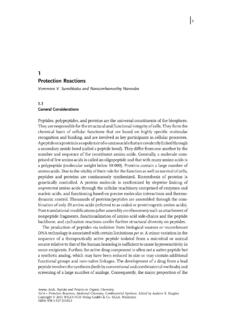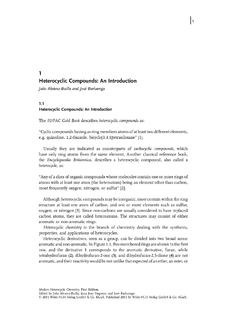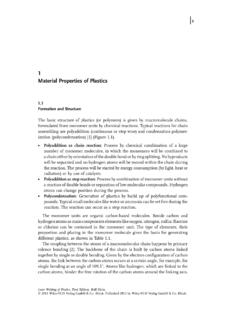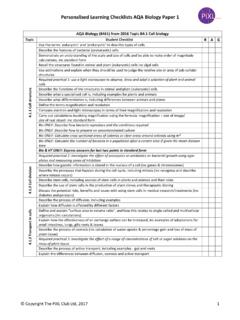Transcription of 1 Basics of Cell Signaling - Wiley-VCH
1 1 Basics of Cell Signaling : Why, When and Where?One characteristic common to all organisms is the dynamic ability tocoordinate constantly their activities with environmental function of communicating with the environment is achievedthrough a number of pathways that receive and process signals ori-ginating from the external environment, from other cells within theorganism and also from different regions within the addition to adapting the function of an organism to environ-mental changes in a signal-directed way, other essential features ofmulticellular organisms require the coordinated control of cellularfunctions as formation and maintenance of the specialized tissues of mul-ticellular organisms depend on the coordinated regulation of cellnumber, cell morphology, cell location and expression of differen-tiated functions. Such coordination results from a complex networkof communication between cells in which signals produced affect tar-get cells where they are transduced into intracellular biochemical re-actions that dictate the physiological function of the target cell ( ).
2 The basis for the coordination of the physiological functionswithin a multicellular organism isintercellular Signaling (or intercel-lular communication), which allows a single cell to influence the be-havior of other cells in a specific manner. As compared to single-cellorganisms, where all cells behave similarly within a broad frame,multicellular organisms contain specialized cells forming distinct tis-sues and organs with specific functions. Therefore, higher organ-isms have to coordinate a large number of physiological activitiessuch as: Intermediary metabolism. Response to external signals. Cell growth. Cell division of Signal Transduction and Regulation. KraussCopyrightc2008 Wiley-VCH Verlag GmbH & Co. KGaA, WeinheimISBN: 978-3-527-31397-6 Differentiation anddevelopment:coordination of expressionprogrammes. Cell motility. Cell generated during intercellular communication must be re-ceived and processed in the target cells to trigger the many intracel-lular biochemical reactions that underlie the various physiologicalfunctions of an organism.
3 Typically, many steps are involved in theprocessing of the signal within the cell, which is broadly describedasintracellular transduction within the target cellmust be coordinated, fine-tuned and channeled within a networkof intracellular Signaling paths that finally trigger distinct biochem-ical reactions and thus determine the specific functions of a cell. Im-portantly, both intercellular and intracellular Signaling are subjectedto regulatory mechanism that allow the coordination of cellular func-tions in a developmental- and tissue-specific of Cell SignalingFig. :Inter- and intracellularsignaling. The major way ofintercellular communicationuses messenger substances(hormones) that are secretedby signal-producing cells andare registered by target cells produce and receivemultiple, diverse signals. Theextracellular signals are trans-duced into intracellular signalingchains that control many of thebiochemical activities of a celland can trigger the formationof further extracellular Signaling Communicationbetween cellsIntracellular Signaling Signaling chains withinthe cell, responding toextracellular and intra- cellular SignalingIntercellular signal transduction influences nearly every physiologi-cal reaction.
4 It ensures that all cells of a particular type receive andtransform a signal. In this manner, cells of the same type react syn-chronously to a signal. A further function of intercellular communi-cation is the coordination of metabolite fluxes between cells of var-ious higher organisms intercellular Signaling pathways have the im-portant task of coordinating and regulating cell division. The path-ways ensure that cells divide synchronously and, if necessary, arrestcell division and enter a resting communication assumes great importance in the differen-tiation and development of an organism. The development of an or-ganism is based on genetic programs that always utilize inter- andintracellular Signaling pathways. Signal molecules produced by onecell influence and change the function and morphology of othercells in the Signaling pathways are also critical for the processingof sensory information. External stimuli, such as optical and acousticsignals, stress, gradients of nutrients, etc.
5 , are registered in sensorycells and are transmitted to other cells of the organism via intercel-lular Signaling for Intercellular SignalingWecurrently know of various forms of communication between cells(Fig. ): Extracellular send out signals in the form of spe-cific messenger molecules that the target cell transmits into a bio-chemical reaction. Signaling cells can simultaneously influencemany cells by messenger molecules so as to enable a temporallycoordinated reaction in an organism. between bordering cells is possiblevia direct contact in the form of gap junctions . Gap junctions arechannels that connect two neighboring cells to allow a directexchange of metabolites and Signaling molecules between the cells. Cell cell interaction via cell surface form of directcommunication between cells occurs with the help of surfaceproteins. In this process a cell surface protein of one cell binds aspecific complementary protein on another cell.
6 As a consequenceof the complex formation, an intracellular signal chain is activatedwhich initiates specific biochemical reactions in the Intercellular SignalingIntercellular signalingcontrols Metabolic fluxes Cell division Growth Differentiation Development Processes sensoryinformationcells. Communication is then only possible upon direct contactbetween the target cell with the surface protein of the partner cell. Electrical intercellular communication mechan-ism relies on electrical processes. The conduction of electricalimpulses by nerve cells is based on changes in the membranepotential. The nerve cell uses these changes to communicate withother cells at specialized nerve endings (synapses). It is central tothis type of intercellular communication that electrical signals canbe transformed into chemical signals. This type of communicationwill not be discussed in this the following, the main emphasis will be on the intercellular com-munication via extracellular messengers the of Cell SignalingFig.
7 :Principal mechanismsof intercellular communication.(a) Communication via intercel-lular messengers. (b) Commu-nication via gap junctions. Gapjunctions are direct connectionsbetween cells. They are coatedby proteins (drawn as circles)that can have a regulatory influ-ence on the transport . (c) Com-munication via surface communicate via Messenger substances Gap junctions Surface proteins Electrical of Intercellular SignalingIn the communication between cells of an organism, the signals(messengers such as hormones) are produced in specialized signal-producing function of these cells is itself regulated, sothat the signal is only produced upon a particular stimulus. In thisway Signaling pathways can be coupled to one another and coordi-nated. The following steps are involved in intercellular communica-tion (Fig. ).Formation of a Signal in the Signal-producing Cellas a Result of an External TriggerMost extracellular messengers are produced in response to externaltriggers and are released by exocytosis.
8 Physical stimuli like electricalsignals, changes in ion concentration or, most frequently, other extra- cellular Signaling molecules serve as a trigger to increase the amountof the messenger available for extracellular communication. The Intercellular SignalingFig. :The individual stepsof intercellular reception of a triggeringstimulus, the signal is trans-formed into a chemicalmessenger within the signalingcell. The messenger is secretedand transported to the targetcell, where the signal is regis-tered, transmitted further andfinally converted into a bio-chemical reaction. Not shownare processes of termination orregulation of communicationwhich can act at any of the by which the external trigger signals increase the amountof extracellular messenger are diverse, and include stimulation of thebiosynthesis of the messenger, increased production of the maturemessenger from precursors and release of the messenger from astore form.
9 The latter mechanism is extensively used in the releaseof hormones of the neural system (neurotransmitters) in responseto electrical signals, at of the Signal to the Target CellThe extracellular signal produced may be distributed via the circula-tion or it may reach the target cell simply by diffusion. In long-rangesignaling via the circulation, the extracellular messenger is oftenbound to specific carrier proteins or incorporated into larger proteincomplexes. This may serve to prevent degradation in the extracellularmedium or to provide for docking to specific cells only. Furthermore,processing or metabolization of a messenger during transport mayconvert it from an inactive form to an active of the Signal in the Target CellAtarget cell that receives a signal within the framework of intercellu-lar communication transmits the signal inintracellularpathways thattrigger distinct biochemical activities in a cell-type-specific mannerand determine the response of the target cell.
10 Specialized proteins,termedreceptors,are utilized for the reception of signals in the targetcell. Only those cells that carry the appropriate receptor will be acti-vated for further transduction of the signal into the interior of thecell. The reception of the signals by the receptor is equivalent to thebinding of messenger substance on the receptor or the transmissionof physical stimuli into a structural change in the are two principal ways by which target cells can process in-coming signals: Cell surface receptors receive the signal ( a messenger sub-stance) at the outside of the cell, become activated and initiate asignaling chain in the interior of the cell. In such Signaling path-ways, the membrane-bound receptor transduces the signal at thecell membrane so that it is not necessary for the signal to actuallyenter the cell. The messenger enters into the target cell and binds and activatesthe receptor localized in the cytosol or of Cell SignalingSteps of intercellularsignaling Trigger signal inducesrelease of stored mes-senger or stimulates itsbiosynthesis transport to target cell Receipt of signal by thetarget cell Conversion of signalinto intracellular signalchain in the target of Intercellular SignalingThe result of communication between the Signaling and receivingcells is a defined biochemical reaction in the target cell.














